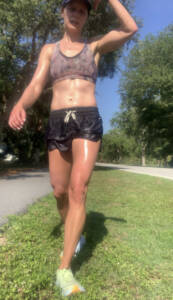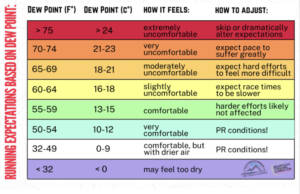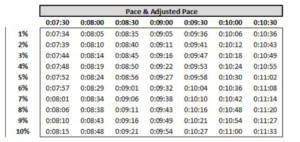Summer has arrived and for many of us that means that the humidity has arrived, too. Running in humidity poses more of a challenge than running in many other weather conditions. It can also pose health risks.
I live in Tennessee where running in high humidity is my reality in the summer months. We also vacation in Charleston, SC for part of the summer which is basically a swamp—so yeah, running in humid weather is something I have learned to live with.

But it hasn’t been easy. There is certainly an adjustment period to running in humidity and changing your mindset (and training) is crucial for success. I’ve had terrible workouts, lost my confidence, and gotten sick to my stomach because I didn’t account for the humidity.
In this article, I want to help you cope with running in humid weather. Why? Because I want you to avoid these things and not let humid weather stand in the way of your running goals.
In this article, I dig into the research and chat with exercise physiologist Todd Buckingham to cover:
- A primer on humidity, dewpoint, heat index and “feels like” temperature
- Why running in humidity feels harder
- What’s harder—running in high humidity or altitude
- Benefits of running in humidity
- Calculators to adjust your training for hot and humid weather
- 8 tips to make running in humidity easier
Let’s roll!
What are humidity and dew point?
Let’s do a quick primer on the difference between humidity and dew point:
Humidity:
Humidity is a relative measure of the amount of moisture in the air and is measured by a percentage. When the temperature is higher, the air can hold more moisture inside of it. So 100% humidity at 50 degrees is less than 100% humidity at 100 degrees.
Dew point:
Dew point is an absolute measure, and it is the temperature the air must cool down to become saturated with condensation and for dew to form. Therefore, the dew point is 85, then that’s the temperature sweat will collect on your skin and not evaporate.

For this reason, dew point matters more than humidity when it comes to running comfort. The humidity can be high but if the temperature is low, then running won’t feel uncomfortable because there’s less moisture in the air and thus your sweat can evaporate at lower temperatures.
However, if both the humidity and temperatures are high (and thus the dew point is high), running is uncomfortable or even awful. In these conditions, there is more moisture in the air and your sweat.
Here’s your cheat sheet:
- High humidity + low temps=comfortable running weather
- High humidity + high temps=uncomfortable running weather
- Low dewpoint=comfortable running weather (60- degrees)
- High dewpoint=uncomfortable running weather (70+ degrees)
According to Buckingham, here’s how dewpoints affect running:
- Anything below a dew point of 60 degrees is typically comfortable for almost everyone. Between 60-65 degrees is when it starts to get uncomfortable for some.
- Between 65-70 degrees it becomes uncomfortable for almost everyone.
- Between 70-75 degrees it becomes very uncomfortable.
- Between 75-80 degrees it becomes almost oppressive.
- And above 80* degrees it’s not recommended to run.
You can check dew point on any weather app.
Related: How to Get Used to Running in the Heat
How does humidity affect the feels like temp or heat index?
The “feels like” temperature (or heat index) is what the temperature outside feels like to the body. This measurement is a combination of the actual temperature and the relative humidity. In addition to looking at dew point, runners can look at the heat index.
More on how to use this information to adjust your training below.
Running and Humidity
So, now let’s get to how humidity and running affect each other.
Does humidity make running harder?

Yes, running in the humidity makes completing your run more challenging. Running when it’s hot makes your heart rate rise more rapidly which makes the run harder on your body.
When you add humidity to the hot mix, running can feel like a hot mess. This is because on top of your body working hard to cool itself, it’s hard work is going to waste. Your sweat can’t evaporate into the wet air, so your body isn’t getting any cooler.
On top of that, as you sweat, your blood thickens, making it harder to supply your working muscles with the oxygen they need.
Compounding matters, trying to breathe in humid conditions can be difficult for some people and it can feel as though you can’t get a full breath. This is because the air is more saturated with water than oxygen so with every breath you are taking in more water than oxygen. As you might imagine, this can greatly impact your ability to run.
Related: How to Run with Asthma
How does the body respond to running in humidity?
When you run in high humidity and heat, your body is not able to effectively release body heat and cool itself down. Normally sweating would cool you down by evaporating on your skin. When it’s humid the heat stays trapped inside of your body.
The increased sweating also puts you at risk of dehydration, which will cause your body to prioritize blood flow to your essential organs. This means that less blood flow goes to your digestive system which may cause you to feel nauseous. Your breathing may become shallow, and you might develop a stitch (pain) in your sides.
Related: How to Stop a Side Stitch
Oddly enough you may even feel cold or chilled despite the high temperatures. This happens because your body can lose the ability to regulate its temperature due to the heat.
What’s harder to run in humidity or altitude?
Running in humidity and altitude both present their own unique challenges, but they have similar effects on your running performance. Running at high altitudes makes your body work harder to run the same distance and pace as you would at sea level.

Over time, as your body acclimates to the higher altitude, your body produces more red blood cells. These cells will deliver more oxygen to your muscles. This will make it easier to run at higher altitudes.
Running in high humidity doesn’t produce more red blood cells. It does cause physiological changes in the body that will help you run better and faster when the temperatures drop back down though.
Related: Benefits of Running in Heat
Benefits of Running in Humidity
There are some benefits of running in humidity:
Related: Pro Race Day Running Tips
-
Stronger cardiovascular system:
When you run in high humidity or heat, you will have increased plasma volume, says Buckingham. By causing your body to sweat more, you send a signal to the body that it needs to produce more blood plasma. Having more blood plasma decreases the work the heart has to do to pump blood through the body and makes it easier for the red blood cells to travel to the muscle to provide them with oxygen.
-
Mental toughness:
Running in humidity teaches you to adapt to the conditions, even if they are difficult, and stick with it—no matter if the outcome is undesirable. This mental strength sets you up for success on race day.
-
Enhanced performance come fall:
A stronger body and mindset you up for success once the temperatures cool. Peak running temperatures are in the 40s. When the temperature and humidity drops, your body will be an efficient machine, giving your muscles the oxygen they need to go fast and far.
Is it harder to run in humidity or heat?
Running in humidity AND heat is hard. The heat makes it uncomfortable, but the addition of humidity can make it downright unbearable.
Running in humidity increases your heart rate and effort, and you will need to adjust your pace accordingly.
You can do this in two ways.
First, find out what the dew point and/or heat index is from your usual weather source.
-
Humidity and running calculator
Use Jack Daniels’ VDOT Calculator and input the “feels like” temperature into the advanced settings section. The calculator will give you pace adjustments.
-
Temp + dew point equation
Use this popular calculation to adjust your pace.
- Add the temperature and the dew point together.
- Find your percentage of adjustment below.
- 100 or less: no pace adjustment is needed

The higher the dew point, the slower you need to run. Credit: Wicked Bonk Proof - 101 to 110: 0% to 0.5% pace adjustment
- 111 to 120: 0.5% to 1.0% pace adjustment
- 121 to 130: 1.0% to 2.0% pace adjustment
- 131 to 140: 2.0% to 3.0% pace adjustment
- 141 to 150: 3.0% to 4.5% pace adjustment
- 151 to 160: 4.5% to 6.0% pace adjustment
- No outdoor running at anything higher
Also, super cool: Strava has a new app plug-in called DewMe that gives you an equivalent pace based on the weather. This feature doesn’t help you adjust before but does help you adjust after–super useful for when your performance is disappointing.
Is it dangerous to run in humidity? What are the risks?
Yes, it can be dangerous to run in high humidity with a risk of heat exhaustion or heat stroke.
The early symptoms of heat stroke or heat exhaustion are:
- dizziness
- headache
- tingly skin
- fatigue
- nausea, and
If you experience any of these symptoms, stop running and go cool off. Read how here.
Related: Hydration Guide for Summer Running
Can I make running in humidity easier?
Yes, there are some steps you can take to make running in humidity easier and safer.
-
Give it time.
Your body will also adjust to running in high humidity in 7 to 10 days, so it will get easier the more often that you do it.
-
Hydrate before, during, and after you run.
Be sure to drink 16-20 ounces of fluids with about 400 mg of sodium before you head out. Aim for about 4 gulps a mile and 400 mg an hour during running. Refuel with what liquid you lost and drink another sports drink with at least 400 mg of sodium. Read all the details of how to hydrate in my hydration guide including what gels, salt tablets, and sports drinks are best.
Related: Best Sports Drinks for Runners
-
Wear the right gear.
Light-colored, loose-fitting, breathable clothing is the best choice for running in the heat and humidity. Consider wearing a visor and/or sunglasses rather than a hat when running in humidity. A hat will trap the heat next to your head, whereas a visor still lets air circulate around your head. If you wear a hat, put ice in it before you go out the door. Also, don’t forget to wear sunscreen!
Related: What is Runner’s Face
-
Run early in the day or in the evening.

Pin these tips for running in humidity for later!
Temperatures will likely be cooler early in the morning and later in the evening. Avoid running during the hottest parts of the day, typically between 11 in the morning and 4 in the afternoon.
Related: How to Become a Morning Runner
-
Opt for trails over asphalt
Try running on shady trails instead of asphalt. Asphalt radiates the heat upward and attracts the sun. Look for bike trails or other nature trails that can also offer some shade.
-
Consider a cooling towel
A cooling towel like this can make running in the heat and humidity a lot more comfortable. These soft microfiber towels are soft, treated with SPF 50, and they stay cold for hours. You can use it to wipe down your face or put it on the back of your neck to keep you cool as you run. Also, stick ice in your sports bra, hat, and water bottle.
-
Adjust your training
Use the pace adjustment calculators to adjust your pace or run by effort. Consider shortening your run or the time on your feet to account for the weather conditions. Also, don’t be afraid of walk breaks.
Related: What is RPE in Running?
-
Take your phone
Running in the humidity and heat does pose some risks to your safety, so make sure that you take your phone with you. This way if you begin feeling unwell, or don’t feel that you can make it back home safely you can call for help. You may also want to let someone know where you are going and what your route will be.
Related: Best Running Gear that Holds Your Phone
Just because the temperatures and humidity are soaring doesn’t mean that you have to stop training. It does mean that you need to take some precautions, like hydrating, wearing sunscreen, and adjusting your pace or distance.
While you are slogging through the humidity on your run, remember to stay positive and take it easy on yourself. Just think about how much better your running performance will be when those temperatures and humidity finally come back down! If you want guidance with your running goals, check out my run coaching services. Also, be sure to check out my free training plans:


